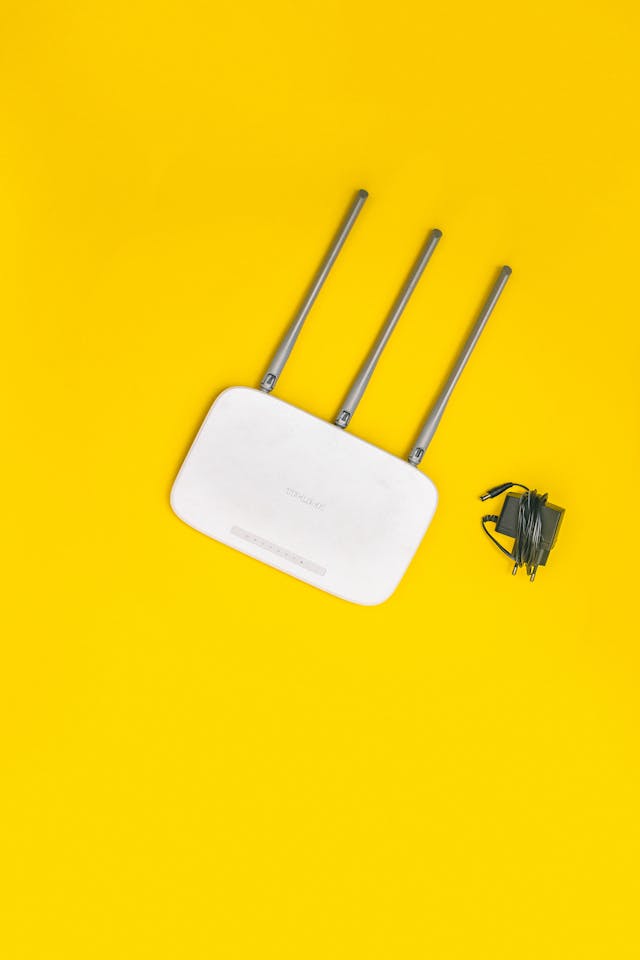10 Tips to Improve Your Wireless Network: Boost Speed and Reliability
Struggling with a slow or unreliable wireless network? You’re not alone. Whether you’re streaming on a Roku, working from home on a MacBook Pro, or gaming on a PS5, a sluggish Wi-Fi signal can disrupt your productivity and entertainment. From interference to outdated routers, many factors can degrade network performance. We’ll share 10 tips to improve your wireless network, covering router placement, equipment upgrades, and interference reduction. Plus, we’ll explore how airplane mode and silent mode can complement your connectivity efforts, ensuring a fast, reliable, and distraction-free experience in the USA.
Topics Covered in This Article
- 1 Why a Strong Wireless Network Matters
- 2 Topics Covered in This Guide
- 3 Why Wireless Networks Slow Down
- 4 10 Tips to Improve Your Wireless Network
- 4.1 1. Choose a Central Location for Your Router
- 4.2 2. Elevate Your Router Off the Floor
- 4.3 3. Upgrade to a High-Gain Antenna
- 4.4 4. Minimize Wireless Interference
- 4.5 5. Upgrade Your Device’s Wireless Adapter
- 4.6 6. Install a Wireless Repeater
- 4.7 7. Switch to a Less Congested Wireless Channel
- 4.8 8. Update Router Firmware and Network Adapter Drivers
- 4.9 9. Use Equipment from One Manufacturer
- 4.10 10. Upgrade to the Latest Wireless Technology
- 5 How Airplane Mode and Silent Mode Enhance Connectivity
- 6 Tips for Using These Strategies Effectively
- 7 Additional Wi-Fi Optimization Resources
- 8 Why a Fast Wireless Network Is Essential
Why a Strong Wireless Network Matters
A robust wireless network is the backbone of modern life, powering smart homes, remote work, and online gaming. Slow Wi-Fi speeds or dropped connections can frustrate users, whether you’re on a Google Pixel 9 or a Dell XPS laptop. By optimizing your Wi-Fi signal, you enhance productivity, streaming quality, and device performance. Pairing wireless network improvements with features like airplane mode (for connectivity control) and silent mode (for notification management) creates a seamless digital experience. Let’s dive into our 10 tips to boost your wireless network.
Topics Covered in This Guide
- Why wireless networks slow down and how to fix them.
- 10 tips to improve your wireless network for speed and reliability.
- How airplane mode and silent mode enhance connectivity and focus.
- Additional Wi-Fi optimization resources for tech users.
Why Wireless Networks Slow Down
Before diving into solutions, let’s understand why wireless networks falter. Common culprits include:
- Interference: Household devices like microwave ovens or cordless phones disrupt Wi-Fi signals.
- Router Placement: Poor router placement (e.g., near walls) weakens signal strength.
- Outdated Equipment: Older routers or network adapters struggle with modern bandwidth demands.
- Channel Congestion: Overlapping Wi-Fi channels in crowded areas reduce network performance.
- Signal Range: Large homes or thick walls limit Wi-Fi coverage.
Our 10 tips address these issues, helping you achieve a fast and stable wireless network.
10 Tips to Improve Your Wireless Network
Here are 10 practical tips to enhance your wireless network, ensuring faster speeds, stronger signals, and reliable connections. Each tip is actionable and tailored for home users, remote workers, and tech enthusiasts.
1. Choose a Central Location for Your Router
Router placement is critical for Wi-Fi coverage. Positioning your router in a central location maximizes signal strength across your home. For example, in a two-story house, place the router on the first floor, ideally on a high shelf, to improve signal reach to the second floor. Avoid corners or external walls, as they waste signal strength outside your home. Brands like Netgear or TP-Link recommend central placement for optimal network performance.
2. Elevate Your Router Off the Floor
Walls, floors, and metal objects (e.g., filing cabinets) can weaken Wi-Fi signals. To minimize interference, keep your router off the floor, ideally on a shelf or table. For instance, a Linksys router placed on a desk avoids signal absorption by carpets or furniture. Ensure the router has ventilation to prevent overheating, which can degrade network performance.
3. Upgrade to a High-Gain Antenna
Most routers come with omnidirectional antennas, broadcasting Wi-Fi signals in all directions. If your router is near an external wall, half the signal may escape outside. Consider replacing the antenna with a high-gain antenna, which focuses the Wi-Fi signal in a specific direction (e.g., toward your living room). ASUS and Netgear routers often support removable antennas, making this upgrade easy. Check your router manual for compatible antennas to boost signal strength.
4. Minimize Wireless Interference
Wireless interference from household devices can disrupt your Wi-Fi network. Common culprits include cordless phones, microwave ovens, baby monitors, and garage door openers, which operate on the same 2.4 GHz frequency as many routers. To reduce interference:
- Switch to 5 GHz or 6 GHz devices (e.g., modern cordless phones).
- Keep your router away from appliances.
- Use Wi-Fi analyzers (e.g., NetSpot) to identify interference sources.
This ensures a cleaner signal for devices like the iPhone 15 or Xbox Series X.
5. Upgrade Your Device’s Wireless Adapter
If your laptop or desktop struggles to send signals back to the router, the issue may lie with its wireless adapter. Older card-based adapters in devices like HP Pavilion laptops often have weak antennas. Replace them with a USB wireless adapter featuring an external antenna (e.g., TP-Link Archer T3U). These adapters improve signal reception and network performance, ensuring reliable connections for video calls or online gaming.
6. Install a Wireless Repeater
For large homes or multi-story buildings, a wireless repeater (or range extender) can boost Wi-Fi coverage. Repeaters rebroadcast your router’s signal, extending it to distant areas (e.g., upstairs bedrooms or basements). Place the repeater halfway between your router and the dead zone, near a power outlet. Brands like Linksys RE7000 or Netgear EX6250 are user-friendly, but research compatibility to avoid network slowdowns. Test signal strength with apps like Speedtest after installation.
7. Switch to a Less Congested Wireless Channel
Wi-Fi routers operate on multiple channels within the 2.4 GHz or 5 GHz bands. In crowded areas (e.g., apartment buildings), overlapping channels cause interference. To fix this:
- Access your router’s configuration page via a browser (e.g., type 192.168.1.1).
- Change the wireless channel to a less congested one (e.g., channels 1, 6, or 11 for 2.4 GHz).
- Use Wi-Fi analyzer apps to identify channel congestion.
Your devices (e.g., Samsung Galaxy S24) will automatically detect the new channel, improving network speed.
8. Update Router Firmware and Network Adapter Drivers
Outdated firmware or drivers can hamper router performance and device connectivity. Router manufacturers like TP-Link or ASUS release firmware updates to enhance speed, security, and stability. To update:
- Visit your router’s website or use its mobile app (e.g., Netgear Nighthawk app).
- Download and install the latest firmware.
Similarly, update your network adapter drivers on Windows laptops or MacBooks via the manufacturer’s website (e.g., Intel, Realtek). Regular updates ensure optimal network performance.
9. Use Equipment from One Manufacturer
While routers and network adapters from different brands are compatible, using gear from the same manufacturer (e.g., Netgear router and Netgear USB adapter) can optimize performance. This is especially true for older homes with thick walls or long-distance connections using Wi-Fi 5 devices. Unified ecosystems reduce compatibility issues, ensuring faster speeds and stronger signals.
10. Upgrade to the Latest Wireless Technology
Older routers (e.g., Wi-Fi 4 or Wi-Fi 5) may struggle with modern bandwidth demands, especially for 4K streaming or multi-device homes. Upgrade to a Wi-Fi 6 or Wi-Fi 6E router (e.g., TP-Link Archer AX73, ASUS RT-AX86U) for:
- Faster speeds: Up to 9.6 Gbps on Wi-Fi 6.
- Better range: Improved signal strength in large homes.
- Multi-device support: Handles dozens of smart devices (e.g., Ring doorbells, Amazon Echo).
Pair with Wi-Fi 6-compatible devices like the iPhone 16 or Samsung Galaxy Z Fold6 for maximum network performance.
How Airplane Mode and Silent Mode Enhance Connectivity
Airplane mode and silent mode complement wireless network optimization by managing connectivity and notifications, creating a distraction-free environment. Here’s how they fit in:
Airplane Mode for Connectivity Control
Airplane mode disables Wi-Fi, cellular, and Bluetooth, reducing interference with your wireless network. For example:
- Troubleshooting: Enable airplane mode on a Google Pixel 8 to test if cellular signals are causing Wi-Fi slowdowns.
- Battery Savings: Use airplane mode during low-signal areas to prevent battery drain from network searching, preserving device performance.
- Ad-Free Experience: Play offline games in airplane mode to avoid ads that strain your Wi-Fi network.
After enabling airplane mode, manually re-enable Wi-Fi to stay connected without cellular interference.
Silent Mode for Notification Management
Silent mode, as seen in apps like Instagram or phone settings, mutes notifications without affecting Wi-Fi connectivity. For instance:
- Instagram Silent Mode: Pauses push notifications for DMs or likes, reducing distractions during work or streaming.
- Phone Silent Mode: Silences ringtones and vibrations, ensuring uninterrupted video calls on a stable Wi-Fi network.
Combining silent mode with wireless network optimizations creates a focused environment, ideal for remote workers or students.
Tips for Using These Strategies Effectively
To maximize your wireless network improvements, follow these tips:
- Test Signal Strength: Use apps like Speedtest or Wi-Fi Analyzer to measure Wi-Fi speed and signal strength before and after changes.
- Prioritize 5 GHz or 6 GHz: For faster speeds, connect devices like the iPhone 14 to the 5 GHz or 6 GHz band, reserving 2.4 GHz for distant devices.
- Secure Your Network: Set a strong Wi-Fi password and enable WPA3 encryption to prevent bandwidth theft.
- Combine with Airplane Mode: Use airplane mode on smartphones to troubleshoot interference or save battery life.
- Leverage Silent Mode: Activate silent mode on apps to minimize notification pings, enhancing focus during Wi-Fi-heavy tasks.
- Regular Maintenance: Check firmware, drivers, and channel settings monthly to maintain network performance.
Additional Wi-Fi Optimization Resources
Explore these FoxWiki guides for more tech tips:
- How to boost your Wi-Fi signal: Advanced tricks for home connectivity.
- What is a VPN and how does it work: Secure your wireless network with privacy tools.
- Airplane mode: What it is and how to use it: Manage connectivity on flights or travel.
Why a Fast Wireless Network Is Essential
A fast and reliable wireless network powers your smart home, remote work, and entertainment, from Netflix streaming on a Roku to video calls on a MacBook Air. Our 10 tips to improve your wireless network—from router placement to equipment upgrades—ensure stronger signals, faster speeds, and fewer interruptions. Pairing these with airplane mode for connectivity control and silent mode for notification management creates a productive, distraction-free environment. Whether you’re a gamer, remote worker, or tech enthusiast in the USA, these strategies will elevate your Wi-Fi experience.
For more tech tips and connectivity hacks, visit our Internet category. Questions about wireless network optimization? Drop a comment, and we’ll help you achieve lightning-fast Wi-Fi!







